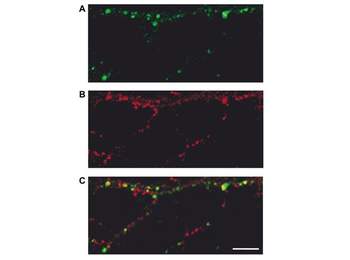You have no items in your shopping cart.
Guinea Pig IgG (H&L) Antibody Texas Red Conjugated Pre-Adsorbed
Catalog Number: orb347056
| Catalog Number | orb347056 |
|---|---|
| Category | Antibodies |
| Description | Guinea Pig IgG (H&L) antibody (Texas Red) |
| Species/Host | Goat |
| Clonality | Polyclonal |
| Tested applications | FC, FLISA, IF |
| Reactivity | Guinea pig |
| Isotype | IgG |
| Immunogen | Guinea Pig IgG whole molecule |
| Concentration | 1.0 mg/mL |
| Dilution range | FLISA: 1:10,000 - 1:50,000, FC: 1:500 - 1:2,500, IF: 1:1,000 - 1:5,000 |
| Form/Appearance | Lyophilized |
| Purity | This product was prepared from monospecific antiserum by immunoaffinity chromatography using Guinea Pig IgG coupled to agarose beads followed by solid phase adsorption(s) to remove any unwanted reactivities. Assay by immunoelectrophoresis resulted in a single precipitin arc against anti-Goat Serum, Guinea Pig IgG and Guinea Pig Serum. No reaction was observed against Bovine, Chicken, Goat, Hamster, Horse, Human, Mouse, Rabbit, Rat and Sheep Serum Proteins. |
| Conjugation | Texas Red |
| Storage | Store vial at 4° C prior to restoration. For extended storage aliquot contents and freeze at -20° C or below. Avoid cycles of freezing and thawing. Centrifuge product if not completely clear after standing at room temperature. This product is stable for several weeks at 4° C as an undiluted liquid. Dilute only prior to immediate use. |
| Buffer/Preservatives | 0.01% (w/v) Sodium Azide |
| Alternative names | Goat Anti-Guinea Pig IgG Texas red Conjugation, Go Read more... |
| Note | For research use only |
| Application notes | This product is designed for immunofluorescence microscopy, fluorescence based plate assays (FLISA) and fluorescent western blotting. This product is also suitable for multiplex analysis, including multicolor imaging, utilizing various commercial platforms. |
| Expiration Date | 12 months from date of receipt. |

(C) Surface distribution of anti-GluR1-4R (green) and anti-GluR1-4GP (red) immunoreactivity on living hippocampal neurons in culture (14 DIV). (D) Colocalization (yellow) of antiGluR1-4R (green) and anti-GluR1-4GP (red) immunoreactivity on the surface of hippocampal neurons. Neuronal cultures were first stained with the anti-GluR1-4R (green) antibody, followed by re-staining with the anti-GluR1-4GP (red) antibody under non-permeabilised conditions (as described at Fig. 1A, without the LTP induction). Scale bars 20 µm.

Changes in AMPAR expression on the surface of living hippocampal neurons following high K + treatment. Dual labelling of hippocampal dendrites showing AMPAR clusters labelled before (A; green and yellow) and following (B; red) the high K + treatment. (C) Colocalization (yellow) of anti-GluR1-4R (green) and anti-GluR1-4GP (red) immunoreactivity on the surface of hippocampal neurons. Note the marked increase in new AMPAR clusters (C; red only). Scale bar 5 µm.

Dual labelling of hippocampal dendrites before (A; green) and following (B; red) the high K+ treatment in the presence of an NMDAR antagonist (5 µm L-689, 560). Colocalization (yellow) of anti-GluR1-4R (green) and anti-GluR1-4GP (red) immunoreactivity on the surface of hippocampal neurons. Note the absence of new (red only) AMPAR clusters on panel C. Scale bar 5 µm.
Rabbit IgG (H&L) Antibody Pre-Adsorbed Texas Red Conjugated [orb347721]
FC, FLISA, IF
Rabbit
Guinea pig
Polyclonal
Texas Red
1 mgGuinea Pig IgG (H&L) Antibody Texas Red Conjugated Pre-Adsorbed [orb347102]
FC, FLISA, IF, WB
Guinea pig
Donkey
Polyclonal
Texas Red
1 mg




